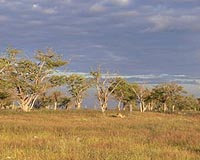| . |  |
. |
Boulder, Colo. (UPI) Jan 7, 2009 Western U.S. sub-alpine forests will soak up less carbon dioxide than they do now as the climate warms and growing seasons lengthen, a university study found. As a result, more of the so-called greenhouse gas will be left to concentrate in the atmosphere, the study by researchers at the University of Colorado in Boulder indicated. "Our findings contradict studies of other ecosystems that conclude longer growing seasons actually increase plant carbon uptake," said Jia Hu, who conducted the research as an ecology and evolutionary-biology graduate student. While a smaller spring snowpack tended to advance the onset of spring and extend the growing season, it also reduced the amount of water available to forests later in the summer and fall, Hu and researcher Russell Monson found in their study published in the February issue of the journal Global Change Biology. The water-stressed trees were then less able to absorb CO2 -- and summer rains were unable to make up the difference, the researchers said. "Snow is much more effective than rain in delivering water to these forests," said Monson, a fellow with the university's Cooperative Institute for Research in Environmental Sciences. Even as late in the season as September and October, 60 percent of the water in stems and needles collected from sub-alpine trees along Colorado's Front Range could be traced back to spring snowmelt, the researchers said. Sub-alpine forests -- including lodgepole pine, sub-alpine fir and Englemann spruce trees growing in mountainous regions just below the timberline -- account for 70 percent of the Western U.S. carbon storage area. Their geographic range includes much of the Rocky Mountains, Sierra Nevada and high-elevation areas of the Pacific Northwest.
Share This Article With Planet Earth
Related Links Forestry News - Global and Local News, Science and Application
 Namibia's landmark quiver trees dying from climate change
Namibia's landmark quiver trees dying from climate changeWindhoek (AFP) Jan 6, 2010 An old man gently touches the trunk of the huge quiver tree with a worried look on his wrinkled face, as he points at several dead branches lying on Namibia's rugged terrain. "When I was a boy, my grandfather made my first quiver from a branch of this old tree about seventy years ago, but I fear the tree is dying -- too many dead branches. Things changed over the past few years, and these tr ... read more |
|
| The content herein, unless otherwise known to be public domain, are Copyright 1995-2009 - SpaceDaily. AFP and UPI Wire Stories are copyright Agence France-Presse and United Press International. ESA Portal Reports are copyright European Space Agency. All NASA sourced material is public domain. Additional copyrights may apply in whole or part to other bona fide parties. Advertising does not imply endorsement,agreement or approval of any opinions, statements or information provided by SpaceDaily on any Web page published or hosted by SpaceDaily. Privacy Statement |